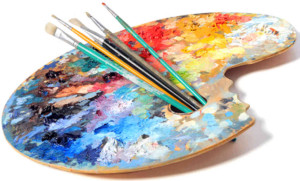Back in 2012, I wrote a blog post talking about how Game Design fits in with STEM Education. I still use those same talking points when I deliver webinars on the subject. Really, none of that has changed. Game Design is still heavily involved in every aspect of STEM education. However, I left out a very important part of Game Design: Art.
 You've no doubt heard of STEM Education, but you may be more unfamiliar with the idea of STEAM education. STEAM education is still Science, Technology, Engineering, and Mathematics. But it acknowledges Art as another discipline. As technology has progressed, we have begun to see art integrate itself with hard sciences in surprising ways. One has to look no further than Apple to realize that a computer can be a fashion statement. This combination of design and technology has brought to light the fact that art itself is being redefined in the 21st century. STEAM Education seeks to not only bolster an understanding of valuable sciences, but to also reignite the creativity of the coming generations. Unfortunately, the United States has seen a drop in creativity since 1990. And creativity is an incredibly important factor in solving new problems, designing new tools, running businesses, and much more. STEAM seeks to teach students the knowledge they need as well as the creativity to use that knowledge in new, innovative ways.
You've no doubt heard of STEM Education, but you may be more unfamiliar with the idea of STEAM education. STEAM education is still Science, Technology, Engineering, and Mathematics. But it acknowledges Art as another discipline. As technology has progressed, we have begun to see art integrate itself with hard sciences in surprising ways. One has to look no further than Apple to realize that a computer can be a fashion statement. This combination of design and technology has brought to light the fact that art itself is being redefined in the 21st century. STEAM Education seeks to not only bolster an understanding of valuable sciences, but to also reignite the creativity of the coming generations. Unfortunately, the United States has seen a drop in creativity since 1990. And creativity is an incredibly important factor in solving new problems, designing new tools, running businesses, and much more. STEAM seeks to teach students the knowledge they need as well as the creativity to use that knowledge in new, innovative ways.
Art & Game Design
So what does this have to do with Game Design? The STEM side of Game Design is well understood but what about Art? Indeed, one of the great questions in the Art world is whether or not video games should actually be considered Art. As time progresses, the line between a computer program and a work of art is beginning to blur. In 2011, The U.S Supreme Court even stated that video games deserve the same first-amendment protections as other art forms.
If you attend any sort of gaming industry event, it's unlikely that you will find anybody who says video games are not art. This is because it is well understood that modern video games require creative sound design, 3D modeling, 2D animating, voice acting, musical composition, cinematography, directing, and much more. And as games continue to develop, we are seeing the medium become more and more creative in ways that people have never seen before in other art forms. It is because of this marriage of disciplines that I consider Game Design to be a subject that meets the definition of Art. I admit that it may be difficult to look at Pong and say "this is art". But take a look at any modern game and it becomes increasingly difficult to say that there is no art involved.
As far as STEAM education goes, modern game design curriculum must include elements such as sound, music, camera movement, lighting, 3D modeling. Even if you are nothing more than a programmer, you will need to have some sort of entry-level understanding of these disciplines to effectively make a game. Even if you have an entire team of professionals behind you, you have to know how to make use of their talents in the best and most creative way possible. Modern games require that art be an integrated part of the game development workflow. It is because of this reason that any curriculum that seeks to teach Game Design must teach some level of Art.
As time progresses and technology improves, we will continue to see the line between software and art blur. A video game may just be a compilation of 1's and 0's, but how you use those 1's and 0's can be absolutely stunning. If you want the all-in-one STEAM solution for your students, look no further than game design.
Author: Mark Philipp
Share this Post
